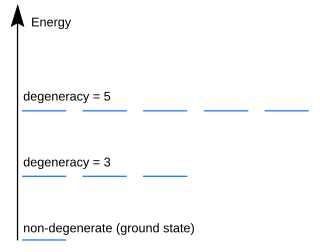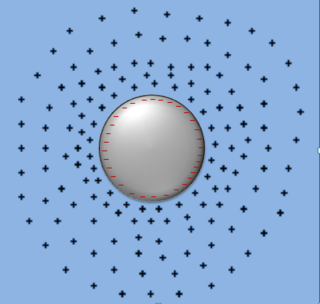
In theoretical physics, quantum field theory (QFT) is a theoretical framework that combines classical field theory, special relativity, and quantum mechanics. QFT is used in particle physics to construct physical models of subatomic particles and in condensed matter physics to construct models of quasiparticles.

In particle physics, quantum electrodynamics (QED) is the relativistic quantum field theory of electrodynamics. In essence, it describes how light and matter interact and is the first theory where full agreement between quantum mechanics and special relativity is achieved. QED mathematically describes all phenomena involving electrically charged particles interacting by means of exchange of photons and represents the quantum counterpart of classical electromagnetism giving a complete account of matter and light interaction.

Julian Seymour Schwinger was a Nobel Prize-winning American theoretical physicist. He is best known for his work on quantum electrodynamics (QED), in particular for developing a relativistically invariant perturbation theory, and for renormalizing QED to one loop order. Schwinger was a physics professor at several universities.

Renormalization is a collection of techniques in quantum field theory, statistical field theory, and the theory of self-similar geometric structures, that are used to treat infinities arising in calculated quantities by altering values of these quantities to compensate for effects of their self-interactions. But even if no infinities arose in loop diagrams in quantum field theory, it could be shown that it would be necessary to renormalize the mass and fields appearing in the original Lagrangian.

An instanton is a notion appearing in theoretical and mathematical physics. An instanton is a classical solution to equations of motion with a finite, non-zero action, either in quantum mechanics or in quantum field theory. More precisely, it is a solution to the equations of motion of the classical field theory on a Euclidean spacetime.
In theoretical physics, a chiral anomaly is the anomalous nonconservation of a chiral current. In everyday terms, it is equivalent to a sealed box that contained equal numbers of left and right-handed bolts, but when opened was found to have more left than right, or vice versa.

Quantum chaos is a branch of physics which studies how chaotic classical dynamical systems can be described in terms of quantum theory. The primary question that quantum chaos seeks to answer is: "What is the relationship between quantum mechanics and classical chaos?" The correspondence principle states that classical mechanics is the classical limit of quantum mechanics, specifically in the limit as the ratio of Planck's constant to the action of the system tends to zero. If this is true, then there must be quantum mechanisms underlying classical chaos. If quantum mechanics does not demonstrate an exponential sensitivity to initial conditions, how can exponential sensitivity to initial conditions arise in classical chaos, which must be the correspondence principle limit of quantum mechanics?

In physics, a coupling constant or gauge coupling parameter, is a number that determines the strength of the force exerted in an interaction. Originally, the coupling constant related the force acting between two static bodies to the "charges" of the bodies divided by the distance squared, , between the bodies; thus: in for Newtonian gravity and in for electrostatic. This description remains valid in modern physics for linear theories with static bodies and massless force carriers.

In theoretical physics, specifically quantum field theory, a beta function, β(g), encodes the dependence of a coupling parameter, g, on the energy scale, μ, of a given physical process described by quantum field theory. It is defined as

In physics the Lamb shift, named after Willis Lamb, refers to an anomalous difference in energy between two electron orbitals in a hydrogen atom. The difference was not predicted by theory and it cannot be derived from the Dirac equation, which predicts identical energies. Hence the Lamb shift refers to a deviation from theory seen in the differing energies contained by the 2S1/2 and 2P1/2 orbitals of the hydrogen atom.
In quantum field theory, and specifically quantum electrodynamics, vacuum polarization describes a process in which a background electromagnetic field produces virtual electron–positron pairs that change the distribution of charges and currents that generated the original electromagnetic field. It is also sometimes referred to as the self-energy of the gauge boson (photon).
The QCD vacuum is the quantum vacuum state of quantum chromodynamics (QCD). It is an example of a non-perturbative vacuum state, characterized by non-vanishing condensates such as the gluon condensate and the quark condensate in the complete theory which includes quarks. The presence of these condensates characterizes the confined phase of quark matter.

In the physics of gauge theories, gauge fixing denotes a mathematical procedure for coping with redundant degrees of freedom in field variables. By definition, a gauge theory represents each physically distinct configuration of the system as an equivalence class of detailed local field configurations. Any two detailed configurations in the same equivalence class are related by a certain transformation, equivalent to a shear along unphysical axes in configuration space. Most of the quantitative physical predictions of a gauge theory can only be obtained under a coherent prescription for suppressing or ignoring these unphysical degrees of freedom.
Chiral perturbation theory (ChPT) is an effective field theory constructed with a Lagrangian consistent with the (approximate) chiral symmetry of quantum chromodynamics (QCD), as well as the other symmetries of parity and charge conjugation. ChPT is a theory which allows one to study the low-energy dynamics of QCD on the basis of this underlying chiral symmetry.

In quantum mechanics, an energy level is degenerate if it corresponds to two or more different measurable states of a quantum system. Conversely, two or more different states of a quantum mechanical system are said to be degenerate if they give the same value of energy upon measurement. The number of different states corresponding to a particular energy level is known as the degree of degeneracy of the level. It is represented mathematically by the Hamiltonian for the system having more than one linearly independent eigenstate with the same energy eigenvalue. When this is the case, energy alone is not enough to characterize what state the system is in, and other quantum numbers are needed to characterize the exact state when distinction is desired. In classical mechanics, this can be understood in terms of different possible trajectories corresponding to the same energy.

The Schwinger effect is a predicted physical phenomenon whereby matter is created by a strong electric field. It is also referred to as the Sauter–Schwinger effect, Schwinger mechanism, or Schwinger pair production. It is a prediction of quantum electrodynamics (QED) in which electron–positron pairs are spontaneously created in the presence of an electric field, thereby causing the decay of the electric field. The effect was originally proposed by Fritz Sauter in 1931 and further important work was carried out by Werner Heisenberg and Hans Heinrich Euler in 1936, though it was not until 1951 that Julian Schwinger gave a complete theoretical description.
The quantum-confined Stark effect (QCSE) describes the effect of an external electric field upon the light absorption spectrum or emission spectrum of a quantum well (QW). In the absence of an external electric field, electrons and holes within the quantum well may only occupy states within a discrete set of energy subbands. Only a discrete set of frequencies of light may be absorbed or emitted by the system. When an external electric field is applied, the electron states shift to lower energies, while the hole states shift to higher energies. This reduces the permitted light absorption or emission frequencies. Additionally, the external electric field shifts electrons and holes to opposite sides of the well, decreasing the overlap integral, which in turn reduces the recombination efficiency of the system. The spatial separation between the electrons and holes is limited by the presence of the potential barriers around the quantum well, meaning that excitons are able to exist in the system even under the influence of an electric field. The quantum-confined Stark effect is used in QCSE optical modulators, which allow optical communications signals to be switched on and off rapidly.

Friedel oscillations, named after French physicist Jacques Friedel, arise from localized perturbations in a metallic or semiconductor system caused by a defect in the Fermi gas or Fermi liquid. Friedel oscillations are a quantum mechanical analog to electric charge screening of charged species in a pool of ions. Whereas electrical charge screening utilizes a point entity treatment to describe the make-up of the ion pool, Friedel oscillations describing fermions in a Fermi fluid or Fermi gas require a quasi-particle or a scattering treatment. Such oscillations depict a characteristic exponential decay in the fermionic density near the perturbation followed by an ongoing sinusoidal decay resembling sinc function. In 2020, magnetic Friedel oscillations were observed on a metal surface.
The so-called double-well potential is one of a number of quartic potentials of considerable interest in quantum mechanics, in quantum field theory and elsewhere for the exploration of various physical phenomena or mathematical properties since it permits in many cases explicit calculation without over-simplification.

In quantum electrodynamics, the Uehling potential describes the interaction potential between two electric charges which, in addition to the classical Coulomb potential, contains an extra term responsible for the electric polarization of the vacuum. This potential was found by Edwin Albrecht Uehling in 1935.














